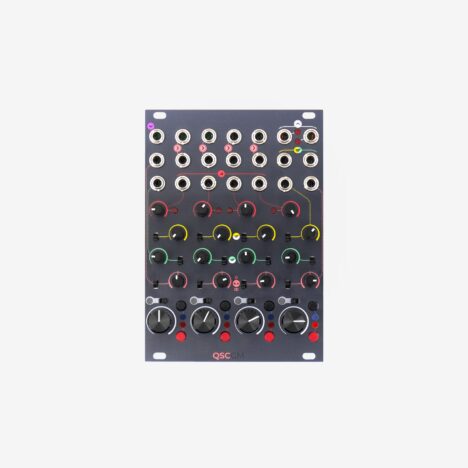- EURORACK
- CUNSA – Sound Seasoning
- CGM – Creative Mixer Series
- BRENSO – Entangled Sound Sources
- USTA – The Voltage Score
- FALISTRI – Movement Manager
- SAPÈL – Tamed Random Source
- FUMANA – Dual 16 Bands Spectral Editor
- 321 – Scale + Flip + Shift + Combine
- 333 – ProAudio Sum & Distribution
- SILTA 2016 – discontinued
- SEI – trunk lines – discontinued
- UNO – foldable case
- PLUS – modular modular case
- ACCESSORIES
- KNOBS
- 500 SERIES
- RESOURCES
- RESELLERS
- ABOUT
- ACCOUNT
Tag / CGM
-
Pan/Crossfade #2
The first and last channels of the QSC feature a voltage-controllable panpot, just like the C channel. However, by combining this feature with the pan/crossfade switch, you can obtain a voltage-controlled crossfader! In this patch, we demonstrate both behaviors with the same CV, a bipolar LFO coming from FALISTRI’s green generator.
2021-09-07 -
Pan/Crossfade #1
With the Quad Stereo Channel, we introduced the pan/crossfade function! If you patch two sound sources to the left and right inputs, you get them panned by default. But if you activate the crossfade switch, the panpot now blends the two sources into a mono output! (Yes, this makes the QSC a rudimentary eight-channel mono mixer…).
2021-09-07 -
Quad Stereo Channel: The Development of a Eurorack Mixer
The idea of a stereo module for the CGM family has been with Frap Tools almost since the early development stage of the channel, group, and master modules. It wasn’t until October…2021-08-10 -
Noise Oscillator #2
What do you use your noise sources for? We can’t have enough so this time, we used the white noise to frequency-modulate BRENSO’s green oscillator, which is also flip-sync’d to the yellow one. It’s almost like tuning the noise!
2021-06-24 -
Exponential VCAs
Today we’ll talk about exponential VCAs in their most popular form: the mixers. To do so, we’ll use the CGM, a voltage-controllable Eurorack mixer!2021-06-01 -
Odd/Even Crossfade
By setting a QSC channel to Crossfade, we can blend the ODD and EVEN bands with a single CV, opening up new sonic routes!
2021-04-21 -
Quadrature Drones
Quadrature Mode is more than just ADSR: in this patch we use it to create two interconnected LFOs, which animate the stereo image of our BRENSO oscillator.
2020-11-02 -
Spectral Sequencing
USTA has 16 outputs, FUMANA 16 bands. Let’s take advantage of this coincidence!
2020-08-31 -
-
Phase Shift
USTA allows you to use ANY CV to shift the phase of one sequence in relation to its clock. You can use a DC offset to obtain a more laid-back sound (if you feel like Dexter Gordon), or any random CV to add some non-destructive degree of unpredictability.
2020-05-31
Categories
Recent Posts
- CUNSA v/s FUMANA: The same patch on two different filters!
- Subharmonic formant arpeggios patch breakdown: a classic Falistri patch!
- Memes aside, let’s make Sandstorm by Darude on our Frap Tools system
- Four tips to use CUNSA as a sound source (including ringing and additive synthesis)
- ‘Glass sounds‘ analog through-zero FM patch breakdown with Brenso and Cunsa!









